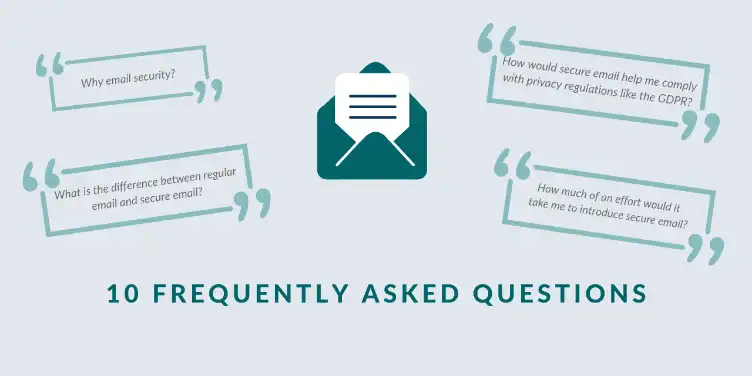Email security remains an interesting topic. And there is a good reason for it: sending data to the wrong recipient is still the biggest cause of data leaks. That is why we have listed the 10 FAQs with answers – so you will understand email security better.
Questions about email security
1. Why email security?
Email security helps your organization to exchange data securely. With the GDPR, which now has been in force for 2 years, organizations are expected to do so.
Secure email is no longer an option, but a must. We don't only take into account sending an email securely - that is, from inbox to inbox, where login details are needed to access the message. No, there is more to cover. When writing a message, during sending and after receiving, there are dangers that can lead to information getting to the wrong person. And that can be prevented with email security, so you as an organization can minimize chances of data leaks.
2. What is the difference between regular email and secure email?
Regular email only ensures that the email ends up in the recipient's inbox. There are no additional security options for sensitive data. In addition, there is no response to awareness, which makes human error easy to occur. Think about:
Secure email provides the user with the means to minimize human error. For example, processing sensitive data can get the right focus, there are adapted security options and incorrectly sent emails, files and recipients can be blocked afterwards. With secure email, there are more options to prevent errors or possibly reverse them.
3. How much effort does it take to introduce secure email?
Not more than the regular “effort” you currently take to send an email. Email security is integrated into your email environment and therefore no different from the way you use email now. Whether you use software that can be used as a plug-in within your email environment or integrate secure email with an API or SMTP Relay Service: in all cases, work processes won't get disrupted.
4. How does secure email help to comply with regulations such as the GDPR?
Secure email is part of secure communication. Therefore, it is important to comply with privacy regulations. With the GDPR, organizations are expected to take the right measures to process personal data in a correct way. In email security, this means that users must have the right tools to be able to respond to this.
Smartlockr makes this possible, for example, by using zero-knowledge end-to-end encryption, two-factor authentication and logging. By doing so, you can always track how data is used, sent and processed.
5. How can phishing emails be stopped with email security?
Phishing emails are about recognizing strange content and deviations. Email security raises awareness when sensitive data is used in emails: by training employees, this specific content can be recognized and the right behavior for secure email can be stimulated. Phishing emails are external factors that come in unsolicited, but for which the correct action must be taken.
6. Should everyone with whom I want to email securely use the same program?
No, fortunately, systems can communicate well with each other nowadays. That means that not everyone has to use the same email program. For example, Smartlockr is interoperable. This means that both the Smartlockr user communicates securely, as well as the receiver, who might use another system.
7. What is the ROI of email security?
The actual ROI depends on a lot of things: the chosen package, the number of licenses and the duration of a contract. However, something we can all agree on, is that the cost of any data leak will be many times higher than the investment in email security:
- The financial aftermath of a data leak can take longer than you’d expect, so as an organization, financial losses are inevitable.
- The average cost of a data breach is $4.4 million.
8. If standard email is not secure, doesn't that generally make email unsafe to use?
Email is, and remains, a popular way of communicating. It is accessible, saves time to exchange files and is easy to use. In this digital era we now live in, secure communication must also be adapted to this by offering the right security. This should also apply to the exchange of sensitive data, since this kind of data is exchanged daily. And we want that quickly, securely and as efficiently as possible.
So it is not about not using a solution because it wouldn’t be secure. But, by offering a secure solution to enable the secure exchange of it.
9. What should I pay attention to when choosing a secure email solution?
First of all, security comes first: a solution that has proven effectiveness will also be able to keep your data secure. In addition, there are three other things you need to keep in mind:
Having access to a secure solution is one thing, but being able to use it the right way is something else.

10. What are the biggest email threats at the moment, and how can I respond to these as an organization?
There are several dangers, and a distinction can be made between internal and external factors. Phishing emails and cyberattacks are external threats that can appear unsolicited. By using a system that securely processes, transmits and stores data, the consequences of external factors can be limited. That depends, among other things, on the nature of the attack and the systems and knowledge that are deployed.
If we look closely, we see that the biggest email threats come from within the organization. It is your employees who are the weakest link and pose an increased risk of data breaches, intentionally or unintentionally. 74% of data breaches are due to human error, according to Verizon's research. By limiting human errors, you can minimize data being shared with the wrong recipients.

